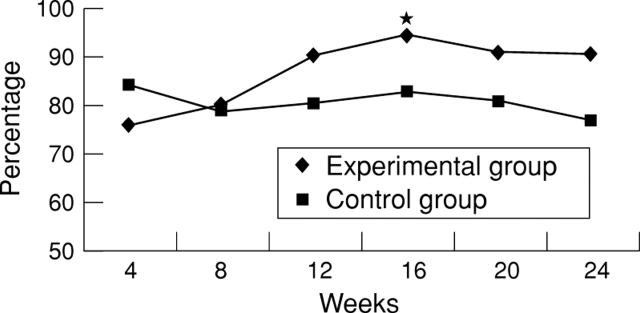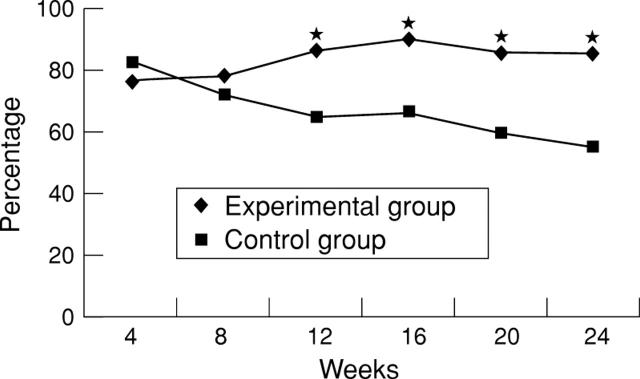Abstract
OBJECTIVE—To determine whether a patient education programme (PE) would improve rates of adherence to a slow acting antirheumatic drug and to assess any subsequent effect on patient outcome. METHODS—A randomly controlled study comprising 100 patients with rheumatoid arthritis (49 control CG; 51 experimental EG) requiring D-penicillamine (DPA). The same practitioner saw patients on seven occasions, for the same length of time. The EG received 7 × 30 minute one to one sessions of PE, while the CG received standard management. The primary measure of adherence was a pharmacological marker (phenobarbitone) encapsulated with the DPA assayed at monthly intervals for six months. Plasma viscosity (PV), C reactive protein, articular index, morning stiffness, and pain score were used to assess outcome. RESULTS—454 blood samples were collected and assayed and the pharmacological marker showed the EG to be significantly more adherent on more occasions than the CG (p<0.05). Patterns of adherence over time showed that at 12 weeks 86% (38/44) of those in the EG compared with 64% (29/45) of the CG remained adherent (p=0.01). These trends continued and by the end of the study 85% (29/34) of the EG compared with 55% (23/42) of the CG were taking their DPA as prescribed. Fifteen patients (12 from the EG) experienced side effects requiring study withdrawal and 14 patients requested study withdrawal (two from the EG). On study entry patients in the CG had significantly higher levels of PV than the EG and this remained so throughout the research. However, on completion, the health status of patients in both groups had improved significantly (p<0.01). CONCLUSIONS—PE significantly increased adherence to DPA and its effects persisted over a period of six months. No additional clinical benefit was detected in the EG in comparison with the CG.
Full Text
The Full Text of this article is available as a PDF (160.5 KB).
Figure 1 .
Levels of adherence over a six month period—analysis 1. *Difference significant at the 5% level.
Figure 2 .
Levels of adherence over a six month period—analysis 2. *Difference significant at the 5% level.
Selected References
These references are in PubMed. This may not be the complete list of references from this article.
- Arnett F. C., Edworthy S. M., Bloch D. A., McShane D. J., Fries J. F., Cooper N. S., Healey L. A., Kaplan S. R., Liang M. H., Luthra H. S. The American Rheumatism Association 1987 revised criteria for the classification of rheumatoid arthritis. Arthritis Rheum. 1988 Mar;31(3):315–324. doi: 10.1002/art.1780310302. [DOI] [PubMed] [Google Scholar]
- Bandura A. Self-efficacy: toward a unifying theory of behavioral change. Psychol Rev. 1977 Mar;84(2):191–215. doi: 10.1037//0033-295x.84.2.191. [DOI] [PubMed] [Google Scholar]
- Barlow J. H., Turner A. P., Wright C. C. Long-term outcomes of an arthritis self-management programme. Br J Rheumatol. 1998 Dec;37(12):1315–1319. doi: 10.1093/rheumatology/37.12.1315. [DOI] [PubMed] [Google Scholar]
- Belcon M. C., Haynes R. B., Tugwell P. A critical review of compliance studies in rheumatoid arthritis. Arthritis Rheum. 1984 Nov;27(11):1227–1233. doi: 10.1002/art.1780271104. [DOI] [PubMed] [Google Scholar]
- Bignell C. J., Mulcahy F. M., Peaker S., Pullar T., Feely M. P. Measuring treatment compliance of men with non-gonococcal urethritis receiving oxytetracycline combined with low dose phenobarbitone. Genitourin Med. 1988 Oct;64(5):312–315. doi: 10.1136/sti.64.5.312. [DOI] [PMC free article] [PubMed] [Google Scholar]
- Bradley L. A. Adherence with treatment regimens among adult rheumatoid arthritis patients: current status and future directions. Arthritis Care Res. 1989 Sep;2(3):S33–S39. doi: 10.1002/anr.1790020312. [DOI] [PubMed] [Google Scholar]
- Brooks P. M., Miners J. O., Smith K., Smith M. D., Fearnley I., Birkett D. J. Dose, plasma concentration and response relationships of D-penicillamine in patients with rheumatoid arthritis. J Rheumatol. 1984 Dec;11(6):772–775. [PubMed] [Google Scholar]
- Brus H. L., van de Laar M. A., Taal E., Rasker J. J., Wiegman O. Effects of patient education on compliance with basic treatment regimens and health in recent onset active rheumatoid arthritis. Ann Rheum Dis. 1998 Mar;57(3):146–151. doi: 10.1136/ard.57.3.146. [DOI] [PMC free article] [PubMed] [Google Scholar]
- Butler M., Carruthers G., Harth M., Freeman D., Percy J., Rabenstein D. Pharmacokinetics of reduced D-penicillamine in patients with rheumatoid arthritis. Arthritis Rheum. 1982 Jan;25(1):111–116. doi: 10.1002/art.1780250120. [DOI] [PubMed] [Google Scholar]
- Donovan J. L., Blake D. R. Patient non-compliance: deviance or reasoned decision-making? Soc Sci Med. 1992 Mar;34(5):507–513. doi: 10.1016/0277-9536(92)90206-6. [DOI] [PubMed] [Google Scholar]
- Doyle D. V., Perrett D., Foster O. J., Ensor M., Scott D. L. The long-term use of D-penicillamine for treating rheumatoid arthritis: is continuous therapy necessary? Br J Rheumatol. 1993 Jul;32(7):614–617. doi: 10.1093/rheumatology/32.7.614. [DOI] [PubMed] [Google Scholar]
- Dunbar J., Dunning E. J., Dwyer K. Compliance measurement with arthritis regimen. Arthritis Care Res. 1989 Sep;2(3):S8–16. doi: 10.1002/anr.1790020309. [DOI] [PubMed] [Google Scholar]
- Hawley D. J. Psycho-educational interventions in the treatment of arthritis. Baillieres Clin Rheumatol. 1995 Nov;9(4):803–823. doi: 10.1016/s0950-3579(05)80315-2. [DOI] [PubMed] [Google Scholar]
- Helliwell P. S., O'Hara M., Holdsworth J., Hesselden A., King T., Evans P. A 12-month randomized controlled trial of patient education on radiographic changes and quality of life in early rheumatoid arthritis. Rheumatology (Oxford) 1999 Apr;38(4):303–308. doi: 10.1093/rheumatology/38.4.303. [DOI] [PubMed] [Google Scholar]
- Hill J., Bird H. A., Hopkins R., Lawton C., Wright V. The development and use of Patient Knowledge Questionnaire in rheumatoid arthritis. Br J Rheumatol. 1991 Feb;30(1):45–49. doi: 10.1093/rheumatology/30.1.45. [DOI] [PubMed] [Google Scholar]
- Hirano P. C., Laurent D. D., Lorig K. Arthritis patient education studies, 1987-1991: a review of the literature. Patient Educ Couns. 1994 Aug;24(1):9–54. doi: 10.1016/0738-3991(94)90024-8. [DOI] [PubMed] [Google Scholar]
- Lindroth Y., Bauman A., Brooks P. M., Priestley D. A 5-year follow-up of a controlled trial of an arthritis education programme. Br J Rheumatol. 1995 Jul;34(7):647–652. doi: 10.1093/rheumatology/34.7.647. [DOI] [PubMed] [Google Scholar]
- Lorig K., Holman H. Arthritis self-management studies: a twelve-year review. Health Educ Q. 1993 Spring;20(1):17–28. doi: 10.1177/109019819302000104. [DOI] [PubMed] [Google Scholar]
- Lorig K., Konkol L., Gonzalez V. Arthritis patient education: a review of the literature. Patient Educ Couns. 1987 Dec;10(3):207–252. doi: 10.1016/0738-3991(87)90126-1. [DOI] [PubMed] [Google Scholar]
- McIntosh E. The cost of rheumatoid arthritis. Br J Rheumatol. 1996 Aug;35(8):781–790. doi: 10.1093/rheumatology/35.8.781. [DOI] [PubMed] [Google Scholar]
- Owen S. G., Friesen W. T., Roberts M. S., Flux W. Determinants of compliance in rheumatoid arthritic patients assessed in their home environment. Br J Rheumatol. 1985 Nov;24(4):313–320. doi: 10.1093/rheumatology/24.4.313. [DOI] [PubMed] [Google Scholar]
- Peaker S., Mehta A. C., Kumar S., Feely M. Measurement of low (sub-therapeutic) phenobarbitone levels in plasma by high-performance liquid chromatography: application to patient compliance studies. J Chromatogr. 1989 Dec 29;497:308–312. doi: 10.1016/0378-4347(89)80034-9. [DOI] [PubMed] [Google Scholar]
- Peveler R., George C., Kinmonth A. L., Campbell M., Thompson C. Effect of antidepressant drug counselling and information leaflets on adherence to drug treatment in primary care: randomised controlled trial. BMJ. 1999 Sep 4;319(7210):612–615. doi: 10.1136/bmj.319.7210.612. [DOI] [PMC free article] [PubMed] [Google Scholar]
- Pincus T. Formal educational level--a marker for the importance of behavioral variables in the pathogenesis, morbidity, and mortality of most diseases? J Rheumatol. 1988 Oct;15(10):1457–1460. [PubMed] [Google Scholar]
- Pullar T. Compliance with drug therapy. Br J Clin Pharmacol. 1991 Nov;32(5):535–539. doi: 10.1111/j.1365-2125.1991.tb03948.x. [DOI] [PMC free article] [PubMed] [Google Scholar]
- Pullar T., Peaker S., Martin M. F., Bird H. A., Feely M. P. The use of a pharmacological indicator to investigate compliance in patients with a poor response to antirheumatic therapy. Br J Rheumatol. 1988 Oct;27(5):381–384. doi: 10.1093/rheumatology/27.5.381. [DOI] [PubMed] [Google Scholar]
- Taal E., Riemsma R. P., Brus H. L., Seydel E. R., Rasker J. J., Wiegman O. Group education for patients with rheumatoid arthritis. Patient Educ Couns. 1993 May;20(2-3):177–187. doi: 10.1016/0738-3991(93)90131-f. [DOI] [PubMed] [Google Scholar]
- Urquhart J. The electronic medication event monitor. Lessons for pharmacotherapy. Clin Pharmacokinet. 1997 May;32(5):345–356. doi: 10.2165/00003088-199732050-00001. [DOI] [PubMed] [Google Scholar]
- Wolff K., Hay A., Raistrick D., Calvert R., Feely M. Measuring compliance in methadone maintenance patients: use of a pharmacologic indicator to "estimate" methadone plasma levels. Clin Pharmacol Ther. 1991 Aug;50(2):199–207. doi: 10.1038/clpt.1991.125. [DOI] [PubMed] [Google Scholar]
- van Gestel A. M., Haagsma C. J., Furst D. E., van Riel P. L. Treatment of early rheumatoid arthritis patients with slow-acting anti-rheumatic drugs (SAARDs). Baillieres Clin Rheumatol. 1997 Feb;11(1):65–82. doi: 10.1016/s0950-3579(97)80033-7. [DOI] [PubMed] [Google Scholar]




